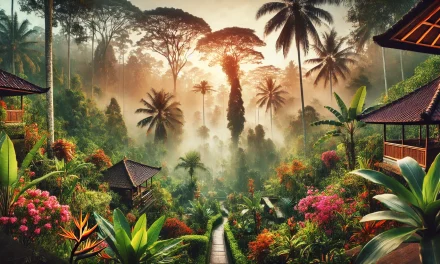Bali—a lush, vibrant island in Indonesia—is not just a getaway for sunbathers and surfers. It’s also a paradise for eco-tourism enthusiasts, teeming with breathtaking natural wonders, rich culture, and sustainable initiatives. But, if you’re aiming to make the most of your eco-friendly adventures, when is the best time to visit Bali for eco tourism? Let’s dive into this enchanting island’s seasons, the activities they offer, and some personal tales that underscore the magic of Bali’s eco-tourism.
Understanding Bali’s Climate
First off, it’s essential to grasp Bali’s climate, which is typically divided into two main seasons: the dry season from April to October and the rainy season from November to March. Each season boasts its own charm and opportunities for eco-tourism, but your choice ultimately depends on what kind of experience you’re after.
Dry Season: April to October
Why Visit During the Dry Season?
The dry season is undoubtedly the most popular time to visit Bali. Imagine this: You arrive in Ubud, the cultural heart of Bali, and it’s a picturesque sunny day with clear blue skies. Sounds perfect, right? Eco-tourism activities such as trekking through the rice terraces, visiting waterfalls, and exploring dense jungles thrive during this period. I vividly recall hiking the Campuhan Ridge Walk in the early morning, surrounded by misty valleys, lush greenery, and the soothing sounds of nature waking up.
During these months, the hiking trails are less slippery, and activities like birdwatching become more accessible, providing a chance to spot Bali’s colorful bird species, such as the exotic Bali starling. Plus, engaging with local conservation projects, like turtle sanctuaries on the northern beaches, is highly rewarding as more volunteers are on hand to guide you.
Practical Eco Adventures:
– Trekking Mount Batur: Perfect for sunrise hikes, where you learn about the local flora and fauna while witnessing a breathtaking view of the sunrise over the volcanic landscape.
– Ubud’s Eco Tours: Join a sustainable farming tour to understand organic rice cultivation and leave with some incredible home-cooked recipes.
– Wildlife Tours: Spot unique wildlife at the Bali Bird Park or join a dolphin-watching tour where operators emphasize responsible wildlife encounters.
Rainy Season: November to March
Why Visit During the Rainy Season?
While the rainy season might not seem like an ideal time to explore, let me share a secret—this is when Bali’s landscape truly flourishes. Think of vibrant green rice paddies glistening after a rainfall, the air filled with the fragrant aroma of wet earth, and fewer tourists making it a more serene experience. On my last trip in January, I found myself in a cozy café in Canggu, sipping organic coffee while the landscape transformed with every rainfall, creating an ever-changing canvas of beauty.
Eco-tourism during the rainy months allows you to really immerse yourself in Bali’s ecosystems. Yes, you might get caught in a shower once in a while, but the magical experience of watching the waterfalls swell with rushing water is worth it.
Practical Eco Adventures:
– Visiting Waterfalls: Explore waterfalls like Tegenungan or Gitgit, where you can swim in their natural pools—though it’s best to check safety conditions during heavy rains!
– Cultural Festivals: Experience the Galungan festival, which holds significant spiritual importance, and witness locals using environmental resources in traditional customs.
– Sustainable Workshops: Join eco-making workshops focused on creating art from recycled materials or organic farming techniques.
What to Consider for Eco Tourism Timing
1. Activities and Experiences
Think about what you want to experience. If you are eager to hike, birdwatch, and enjoy outdoor activities in sunny weather, the dry season might be your best bet. Conversely, if you want to appreciate the lush greenery and partake in quieter excursions, the rainy season can be delightful.
2. Crowd Levels
Bali is a popular tourist destination, and the dry season sees significant tourist influx. If you prefer a less crowded experience while engaging in eco-tourism, the rainy months could be ideal.
3. Wildlife Spotting
If your goal is wildlife spotting, both seasons have advantages. The dry season is usually clearer for birdwatching, while certain species may be more active during the cooler, wetter months.
Personal Experiences: A Tale of Two Seasons
In my personal escapade, I ventured to Bali during both the dry and rainy seasons. In June, against the backdrop of endless blue skies, I relished a day at the Bali Elephant Sanctuary, where I interacted with rescued elephants and learned about their conservation. The experience felt surreal and was sprinkled with the joy of knowing that my visit contributed to their welfare.
Fast forward to a trip in February, where I stumbled upon a mysterious bamboo forest hidden within Ubud, its enchanting paths adorned with glimmering rain droplets. After a spontaneous trek, I found a local eco-friendly café where every meal was crafted from organic ingredients sourced from their own garden. The food was not only nourishing but was closely tied to the land, offering an experience that transcended mere dining.
Conclusion: Timing Your Eco-Adventure
There’s no universally best time to visit Bali for eco-tourism; it truly depends on your preferences and the type of experiences you seek. Whether you’re exploring vibrant landscapes in the dry season or reveling in the peacefulness of the rainy season, one thing is certain—the beauty of Bali’s commitment to eco-friendly practices shines through in every corner of the island. When planning your next trip, take a moment to reflect on the experiences you desire, your comfort with crowds, and your love for nature. Regardless of when you go, Bali’s stunning biodiversity and passionate locals will ensure your eco-adventure is unforgettable. So pack your bags, grab your eco-friendly products, and embark on a journey to explore the rich wonders of Bali—where sustainability meets breath-taking beauty! Happy travels!






